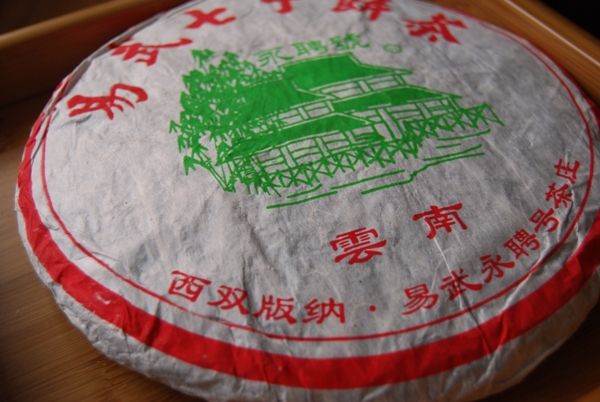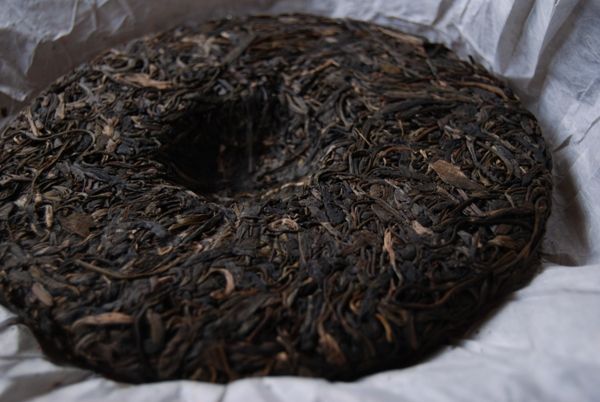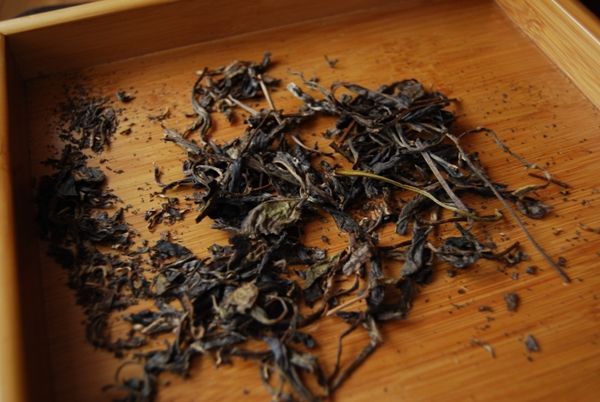A few posts back, DK noted that I seem to enjoy most tea, which made it hard to estimate what I really think of a cake. This is true! I do enjoy most tea, as I wrote in that article. However, let's turn our attention to a few points of interest before we proceed:
(i) My opinion is simply that: an opinion. As Virgil wrote, "Opinions are like excretory orifices, in that everyone has one." I have covered this topic at considerably length in such articles as "Mumonkan", "That Time of the Month" and "That Time of the Month, II". Take it all with a big pinch of salt. That said:
(ii) I believe that tea comes in a few very definite categories:
- Higher-quality tea with a high price, which is probably worth the money
- Higher-quality tea with a high price, which probably isn't worth it
- Higher-quality tea with a low price, and is somewhat of a treasured bargain
- Lower-quality tea with a high price, and which is obviously not worth it
- Lower-quality tea with a low price, and which is probably worth it
- Lower-quality tea with a low price, which isn't worth it
Examples of category #1 include, let's say, some of the upper end of Houde and Essence of Tea products, such as the 2007 Xizihao "Puzhen".
The 2007 Xizihao "Yuanshilin" would be a good example of category #2. It is very nice, but absurdly priced. Some of the 2009-2010 Hailanghao cakes from Yunnan Sourcing may fall in this category, too.
The obvious gold-at-the-end-of-the-rainbow is category #3. The old 2008-2009 Nadacha cakes fell in this category, for me, and perhaps some of the less expensive 2010 Essence of Tea cakes. I've also found some lovely examples of this category in the back-catalogue of Houde. The 2009 Guafengzhai from Yunnan Sourcing was a similar steal*.
*Before its recent price increase - I recall that the original price is still available at Jas-etea.
Category #4 is the most frustrating, comprising cheap tea sold at high prices, usually based on the business model that the customer knows no better. Jing of London fall into this category, for me, such as their bizarre pricing of modern CNNP.
(I draw your attention to the distinction between this outfit and the highly reputed Jing Tea that most of us have loved for over half a decade.)
Cheaper tea at realistic prices is the backbone of most on-line vendors: it is cheap and cheerful, and has relatively honest pricing. I'd put most of Yunnan Sourcing's traditional output in here, along with China Chadao, Red Lantern, Dragon Teahouse, Puerh Shop, and all of the other old favourites. Yes, I'm sure that they all sell some duffers, to varying extents, but there are plenty of cakes from category #5 available from these vendors. They make good daily teas.
Finally, we have category #6: teas that are just plain bad, and cost next-to-nothing. The 2006 Yiwu "Yongpinhao" of this article, like most Yongpinhao, falls into this category, in my estimation. These are cakes that are simply not worth your hours.
I have generally found Yongpinhao products to be over-processed, over-marketed, and very definitely over-rated. Each time I sit down with a new cake from this brand, I am full of hope. Each time, I am disappointed.
It has huge leaves, as you may see illustrated in the above image. You can also see that they are darker and redder than they "should" be, were they raw leaves. This is no problem for a four-year-old cake that costs a trifling 65 RMB ($9.50). I'd be surprised if it were anything else, at that price.
I struggle to fit the lovely long leaves into the pot, and opt to soften them with a little warm water prior to doing so. Even opening the wrapper produces a deliciously sweet aroma. My hopes have never been higher for a Yongpinhao.
The first infusion is just as charming, being sweet and creamy (not unlike the little Douji bricks). It is pungent and full in the mouth, and lasts very well.
Sadly, that's where my hopes pop like a balloon. The second infusion onward crack into a sour and "brown" flavour that will not depart, despite over- or under-brewing. Yongpinhao was ever thus: all promise, and thoroughly intolerable after an infusion or two.
I appreciate MarshalN's recommendation to look at this cake - certainly, it could have easily been a category #5 tea if I had stopped at the first infusion. As it is, I found it to be just the like the rest of the "YPH" product range, and have relegated it to the "I hope this ages into something better" shelves.
There we have it: a tea that I genuinely did not enjoy! They are out there, you just have to look hard for them...
Addendum: this came from 聚今古茶庄 (Jiujin Guchazhuang), from Taobao.
Addendum: this came from 聚今古茶庄 (Jiujin Guchazhuang), from Taobao.





I'm curious how your collection breaks down. What percentage of each group makes up your collection?
ReplyDeleteI like to think that my collection has a break down of about 10% group one, 40% group 3, 30% group 5, and about 20% of group 6 (tuition). Time and will be the true judge of this.
Of course it is easier to categorize younger cakes in this manner. Aged cakes are a different beast and harder to place in any of these categories. I'd say the majority of cakes 10+ years old fit into groups 1 & 4 by default.
*sigh* It's a shame that you've been disappointed by Yong Pin Hao, but I've actually found some winners. I point your attention to the 2007 YPH Yiwu Zheng Shan, Spring from Puerh Shop, which tasted like biting into a really good chocolate bar. Not sure if he still has any of this left, since BBB and I took two of the four tongs he had. Another favorite is the 2008 Manzhuan from Yunnan Sourcing.
ReplyDeleteDear Dave,
ReplyDeleteWhat an interesting question! I don't have very much "grand tea". Maybe 10%, like you. I just can't justify spending so much on one cake, when one could buy a tong of equally good #3 tea.
In fact, I think my numbers look very much like yours! 40% of high-quality, low-priced #3, which I buy hard when I find it. A pile of nice cheaper teas, 30% of group 5, and 20% rubbish #6.
I don't buy much of #5 any more, and so the balance is shifting away from #5 and into #3.
I stay away from #2 and #4 like the plague :)
Dear Maitre Tea,
I'll pop them onto my list for samples to try if I'm buying from those vendors - thanks muchly for the recommendation. I'm sure you're right - there must be some good Yongpinhao out there. I'm always perpetually disappointed, but perhaps that was traditionally because Yunnan Sourcing used to sell it for a reasonably high price, with plenty of hyperbole. Once bitten, twice shy!
Toodlepip,
Hobbes
First thing, given that this is a market that has a lot of hoarding going on, the entry and departure of publically available cakes tends to make this a dynamic one.
ReplyDeleteTake #1. If Puzhen was around in late 2006 or early 2007, would it really be 1 or 2, considering the availability of Yangqinghao 2004 Yiwu and other acclaimed-by-all cakes?
Now, looking at #3 cakes. In 2010, I don't think there are *any* super bargains to be had as far as younger sheng goes. #3 cakes are just members of a broad selection of cakes that are about 11 US cents a gram to 17 cents a gram, and we pick out the good stuff from that continuum. Even though Nada's 2010 are expensive, outside of his bulang and neglecting his Ban Pen, his cakes are 9.5 cents a gram. That's about 12-13 percent off the low end of the pretty good scale for cakes that are more towards the 13-15 cents/grams. It's more that his 2008-2009 cakes were sold at Crazy Ed's prices and can't be regarded as sustainable (or available to the wider populace, i.e. friends and family pricing). XZH, of course, has their B/B+ cakes at the 17 cents side with the JingGu Nuer marking the very outer bounds of reasonableness of pretty good cakes. Of course, some, like the DinJin Nuer and the Xue Shan, blow past even that while not being elite cakes by any stretch.
Next, to me, there are no superb cakes for less than obscene prices. All of the places that give supreme leaf have been found and spoken for, and you kinda have to follow MarshalN's sentiment that super LBZ and Yiwu etc, etc, are all spoken for and cakes available for sale to the public are either too expensive to be worth it or not 100% specified leaf. Therefore, hucksters selling overpriced cakes fill the majority of the vacuum. I like the pretty good and the premium stuff, so I pretty much *have* to follow brands, because aside from complete misses, which are widely mocked and easily avoidable, if I overpay, I still have a tasty cake, and I'd rather overpay than underpay for a not good enough cake--Douji samples really pissed me off with their single mountain cakes in this respect. They are actually reasonable value for the money, but I didn't like their blending philosophy at all.
Which leads me to, in a sense, contradict Maitre Tea. There is a ton of pu out there. There are actual factories that makes good pu but not to your tastes for the most part. I would far rather try another Douji product rather than spend any more sample money on YPH if I had Hobbe's sentiment. It's easy and with no consequence to put a maker of what is dis-satisfactory pu on a blacklist and then spend the sample money on a cheery bing from house YS or DTH lines.
--shah8
Hobbes,
ReplyDeleteIt's too bad you didn't like the cake. I rather enjoyed it and thought it'll age well, fwiw, but tastes differ. Not sure what "brown" flavour means.
Shah8,
The "price per gram" you're quoting is mostly a function of how much markup the Western vendor you're talking to wishes to charge and how many hands the cake has passed through, and has very little actual relationship to the cost of the cake in question. In that sense Nada's cakes may be cheaper, but at the same time, all that matters at the end is whether you like it or not. Following brands, however, is usually a risky bet as few vendors actually have a good amount of control over initial processing of leaves, and small makers (XZH, Nadacha, etc) are usually only involved at the end stage of the production - picking out a few leaves and putting them into cake form, basically. If you can't control the initial processing, then you're not really controlling what tea goes into your cakes all that well.
One primary response: People tend to talk among themselves and create standards of value. I read reviews and interact with people like you, and I get a small sense of what a puerh is supposed to offer. I have, ultimately, very little concern about what the original costs of the cakes were, so long as they pass quality/price ratios common to cakes available in the west. I will, of course, read Hobbes and MarshalN's adventures in TaoBaoLand, but I will most likely never wish to actually purchase something there. I mean, the only cakes I want that I think I could get securely and without trouble is the Dingxing, mostly because yiwu with some strength isn't all that common, and it probably beats something like the 2001 Mingyuanhao silly while being a third to half of the price in the West. Most other cakes I'd want are stuff that's commonly faked, or a quality daily drinker I'd have to go to unusual trouble to get vs YS or DTH.
ReplyDeleteOn the lesser point, I mostly do not care that all a brand does is pick out some leaf and make cakes. My problems with Douji is that they apparently mix radically different grades of leaf--which combined with my lack of skill in consistent brews, is vastly irritating to me. When it comes to places like Pasha where apparently the main owner/grower there likes to do a little Bai Hao/Concubine "organic", then XZH or Haiwan has to take what it can get. However, my favored makers don't make a consistent habit of buying funky processed leaves, and makes cakes out of leaf of mostly the same grade throughout the cake. That's the value of the brand.
--shah8
But since when is "same grade throughout the cake" a marker of quality?
ReplyDeletePart of the job of a good tea maker, some would argue, is precisely to mix in different grades of tea to make a better cake. Otherwise, any monkey can make a good cake. Even leaves from the same mountain are usually blended by the more skilled tea makers out there. They are rarely single source, single estate, single grade. While some may say this is mostly an attempt to lower the cost basis, there's also the very powerful argument that it produces are deeper and more balanced tea in the long run.